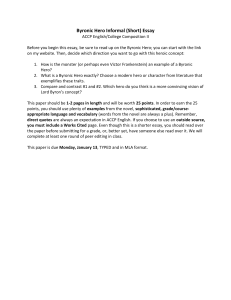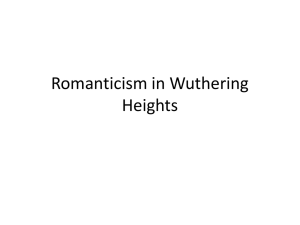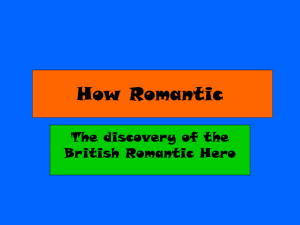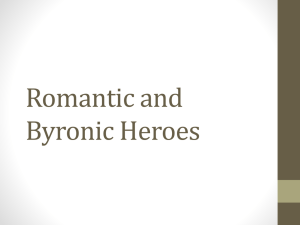Byronic Hero: Characteristics, Origins, and Examples
advertisement
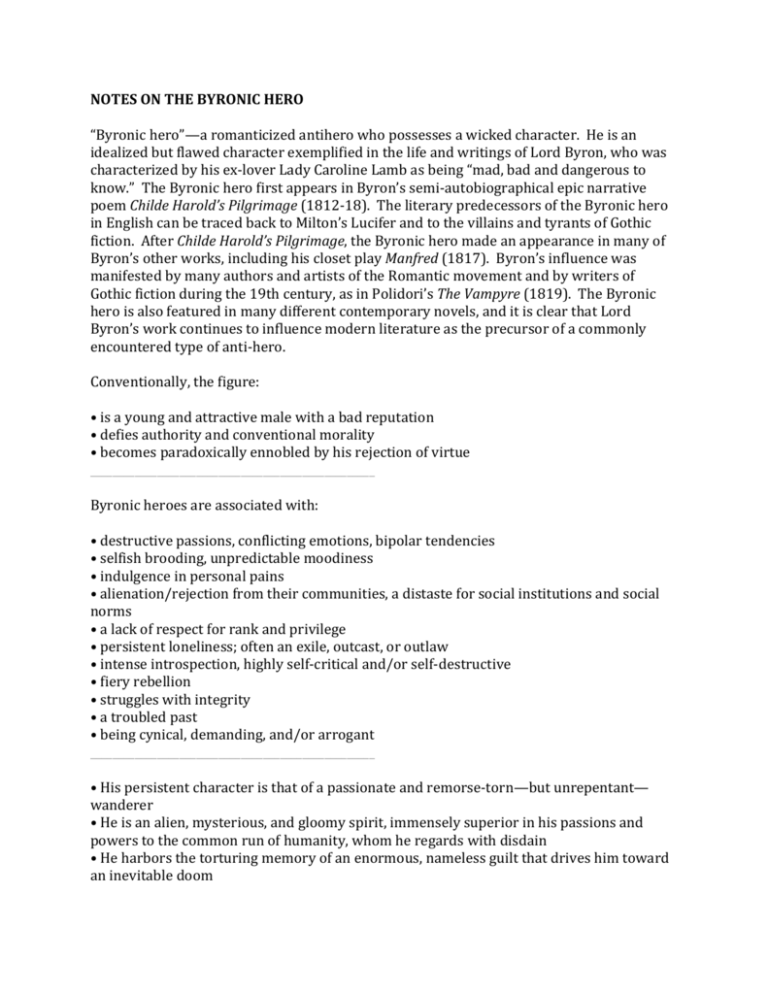
NOTES ON THE BYRONIC HERO “Byronic hero”—a romanticized antihero who possesses a wicked character. He is an idealized but flawed character exemplified in the life and writings of Lord Byron, who was characterized by his ex-­‐lover Lady Caroline Lamb as being “mad, bad and dangerous to know.” The Byronic hero first appears in Byron’s semi-­‐autobiographical epic narrative poem Childe Harold’s Pilgrimage (1812-­‐18). The literary predecessors of the Byronic hero in English can be traced back to Milton’s Lucifer and to the villains and tyrants of Gothic fiction. After Childe Harold’s Pilgrimage, the Byronic hero made an appearance in many of Byron’s other works, including his closet play Manfred (1817). Byron’s influence was manifested by many authors and artists of the Romantic movement and by writers of Gothic fiction during the 19th century, as in Polidori’s The Vampyre (1819). The Byronic hero is also featured in many different contemporary novels, and it is clear that Lord Byron’s work continues to influence modern literature as the precursor of a commonly encountered type of anti-­‐hero. Conventionally, the figure: • is a young and attractive male with a bad reputation • defies authority and conventional morality • becomes paradoxically ennobled by his rejection of virtue ___________________________________________________ Byronic heroes are associated with: • destructive passions, conflicting emotions, bipolar tendencies • selfish brooding, unpredictable moodiness • indulgence in personal pains • alienation/rejection from their communities, a distaste for social institutions and social norms • a lack of respect for rank and privilege • persistent loneliness; often an exile, outcast, or outlaw • intense introspection, highly self-­‐critical and/or self-­‐destructive • fiery rebellion • struggles with integrity • a troubled past • being cynical, demanding, and/or arrogant ___________________________________________________ • His persistent character is that of a passionate and remorse-­‐torn—but unrepentant— wanderer • He is an alien, mysterious, and gloomy spirit, immensely superior in his passions and powers to the common run of humanity, whom he regards with disdain • He harbors the torturing memory of an enormous, nameless guilt that drives him toward an inevitable doom • He is in his isolation absolutely self-­‐reliant, inflexibly pursuing his own ends according to his self-­‐generated moral code against any opposition—human or supernatural • He exerts an attraction on other characters that is the more compelling because it involves their terror at his obliviousness to ordinary human concerns and values (i.e., chicks, even “good” ones, dig him) The Byronic hero is sometimes known as the “villain-­‐hero,” the “Satanic hero,” or the “Promethean hero.” Generally, these are villains of stories who either 1. pose as a hero at the beginning of the story or 2. simply possesses enough heroic characteristics (charisma, sympathetic past, etc.) that either the reader or the other characters see him as more than a simple charlatan or bad guy More specifically: • Satanic hero: a villain-­‐hero whose nefarious deeds and justifications of them make him a more interesting character than the rather bland good hero. • Example: The origin of this prototype comes from Romantic misreadings of Milton’s Paradise Lost, whose Satan poets like Blake and Shelley regarded as a far more compelling figure than the moralistic God of Book III. • Gothic examples: Radcliffe’s Montoni, Wordsworth’s Rivers, Polidori’s Ruthven. • Promethean hero: a villain-­‐hero who has done good but only by performing an over-­‐ reaching or rebellious act. • Prometheus: (from ancient Greek mythology) saved mankind but only after stealing fire and ignoring Zeus’ order that mankind should be kept in a state of subjugation. • Mary Shelley’s Frankenstein is tellingly subtitled the “Modern Prometheus.” • Byronic hero: a later variation of the “antithetically mixed” villain-­‐hero. • Aristocratic, suave, moody, handsome, solitary, secretive, brilliant, cynical, sexually intriguing, and nursing a secret wound, he is renowned because of his fatal attraction for female characters and readers. • This darkly attractive and very conflicted male figure surfaces everywhere in 19th-­‐ and 20th-­‐century art. Damon’s character is Byronic As is DeCaprio’s character in Catch Me if You Can Johnny Depp in Blow Richard Gere in First Knight James Dean, probably the most obvious Byronic figure in 20th-­‐century American film Male Byronic figures, such as Heathcliff and Rochester, are common in Bronte novels In many ways, you’ll see that the qualities that mark this type of hero represent the antithesis of traditional heroism: this hero is not the leader of his people or a representative of his country. He is instead the “archrebel” and it is his rebellious energy, his moody self-­‐isolation, that is the source (to use a phrase from Samuel Taylor Coleridge) of his “savage grandeur.” In his Statesman’s Manual, Coleridge warned against the appeal of the rebellious Romantic hero who functions as a law unto himself. Coleridge, as a philosophical conservative, perceived the danger of giving power to men who could subdue every other consideration to their own ambition. (Think of the mariner in his “Rime of the Ancient Mariner.”) • We are supposed to admire the courageousness of the Byronic/Romantic hero, who, unlike others, is unafraid to explore even the darkest emotions and natural powers • In Byronic heroism, there is an emphasis on introspection (including an exploration of the darker side of the mind), leading to what Harold Bloom has termed the “internalization of the quest romance,” in which one does not quest in the material world but in the world of the mind. Indeed, the Romantic hero goes so far as to believe that the “mind is its own place, and in itself/ Can make a Heav’n of Hell, a Hell of Heav’n,” quoting Milton’s Paradise Lost. Instead of the external battles of old, readers are given an internal battle or “psychomachia.” So what? If one is able to create exclusively through one’s own mind, there is no need, then, for God, nature or even women to ensure creation. • The Byronic/Romantic hero is concerned with ideals rather than convention. These characters flout all conventions and laws in their search for something beyond the ordinary. • The Byronic/Romantic hero exhibits a tendency to suffer; after all, the search for transcendence is, almost by necessity, doomed to failure. These figures are searching for something that is beyond the everyday world, something that therefore cannot be had in the world. As a result, they are often undone by the world of material objects and by the limitations of the flesh. One result of this impossible quest or drive is that it uses up the physical body; the search can often be fatal. • The Byronic/Romantic hero puts everything on the line in search of intensity of feeling, which sometimes puts him on the brink of madness. • The Byronic/Romantic hero values (self-­‐)knowledge over brute strength, which helps to distinguish this figure from the epic heroes of old. • The Byronic/Romantic hero’s quest for extremes of emotion is coupled with a search for the extreme landscapes of nature, i.e. the sublime. Example: Satan is often represented by Romantic artists in sublime landscapes that would normally be the clime of Romantic heroes.
